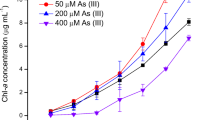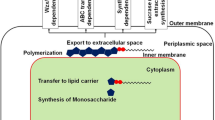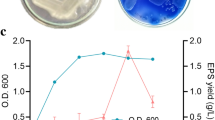Abstract
Exposure of the exopolysaccharide (EPS)-synthesizing cyanobacterium Nostoc spongiaeforme to Zn2+ (20 μM) transformed the biomass into white debris. However, a few blue–green pin-heads emerged after 2 weeks in the same Zn2+-containing medium and formed less mucoid microcolonies (1–2 mm) relative to the protruding colonies (2–4 mm) of the parent strain on nutrient agar. One of such survivors (designated as Zn20) that was stable through 10 successive transfers in Zn2+-lacking medium has been adopted for further characterization. The parent strain retained almost 88% of the total EPS synthesized, the rest being released into the ambient medium, while for Zn20, the EPS retained approximated to 74%. Although the Zn2+-sensitivity of the mutant was comparable with that of the parent (LD50, 7 μM), Zn2+ uptake was still 5-fold higher in the former (2 μg mg−1 biomass dry wt., 20 μM, external concentration). Also, both the strains showed insignificant difference in Zn2+-sorption onto their isolated EPS. The mutant was characterized by having higher cell carbohydrate content (642.8 μg mg−1 dry wt.) than its parent (513.6 μg). The X-ray diffraction pattern revealed Zn2+ deposition on EPS from the parent mainly as zinc hypophosphite monohydrate [Zn(H2PO2)2·H2O], whereas there was a lack of distinct peaks in similar samples from Zn20, thus confirming the amorphous nature. There was participation in Zn2+ binding of only COO−, N=O, NO2, SO2 groups in the parent while participation of P—O and C=O groups in mutant EPS was evident in IR spectra. The observations suggest that the mutant could be deployed to achieve sustained EPS synthesis, its release and metal sorption/desorption in repeated cycles.
Similar content being viewed by others
References
Banfield, J.F. & Nealson, K.H. 1997 Geomicrobiology: Interaction between microbes and minerals. Washington, DC: Mineralogical Society of America. ISBN 0-93995045-6.
Beveridge, T.J. 1981 Ultrastructure, chemistry and function of the bacterial wall. International Review of the Cytology 72, 229–317.
Beveridge, T.J. & Murray, R.G.E. 1980 Sites of metal deposition in the cell wall of Bacillus subtilis. Journal of Bacteriology 141, 876–887.
Beveridge, T.J., Meloche, J.D., Fyfe, W.S. & Murray, R.G.E. 1983 Diagenesis of metals chemically complexed to bacteria: laboratory formation of metal phosphates, sulfide and organic condensates in artificial sediments. Applied and Environmental Microbiology 45, 1094–1108.
Chatterjee, S., Asthana, R.K., Tripathi, A.K. & Singh, S.P. 1996 Metal removal by selected sorbents. Process Biochemistry 31, 457–462.
Choudhury, R. & Srivastava, S. 2001 Mechanism of zinc-resistance in Pseudomonas putida strain S4. World Journal of Microbiology and Biotechnology 17, 149–153.
Daniels, M.J., Turner-Cavet, J.S., Selkirk, R., Sun, H., Parkinson, J.A., Sadler, P.J. & Robinson, N.J. 1998 Coordination of Zn2+ (and Cd2+) by prokaryotic metallothionein: involvement of Hisimidazol. Journal of Biological Chemistry 273, 22957–22961.
De Philippis, R. & Vincenzini, M. 1998 Exocellular polysaccharides from cyanobacteria and their possible applications. FEMS Microbiological Reviews 22, 151–175.
De Philippis, R., Faraloni, C., Margheri, M.C., Sili, C., Herdman, M. & Vincenzini, M. 2000 Morphological and biochemical characterization of the exocellular investments of polysaccharide producing Nostoc strains from the Pasteur culture collection. World Journal of Microbiology and Biotehnology 16, 655–661.
De Philippis, R., Margheri, M.C., Materassi, R. & Vincenzini, M. 1998 Potential of unicellular cyanobacteria from saline environments as exopolysaccharide producers. Applied and Environmental Microbiology 64, 1130–1132.
Dubois, M., Gilles, K.A., Hamilton, J.K., Rebers, P.A. & Smith, F. 1956 Colorimetric method for determination of sugars and related substances. Analytical Chemistry 28, 350–356.
Förstner, U. 1983 Binding forms of heavy-metals in sediments and sludges-sorption, mobilisation, chemical-extraction and bioavailability. Fresenius' Zeitschrift für Analytische Chemie 316, 604–611.
Fortin, D., Davis, B., Southam, G. & Beveridge, T.J. 1995 Biochemical phenomena induced by bacteria within sulfide mine failings. Journal of Industrial Microbiology 14, 178–185.
Gerloff, G.C., Fitzgerald, G.P. & Skoog, F. 1950 The isolation, purification and culture of blue-green algae. American Journal of Botany 27, 216–218.
Gupta, R., Ahuja, P., Khan, S., Saxena, R.K. & Mohapatra, H. 2000 Microbial biosorbents: meeting challenges of heavy metal pollution in aqueous solutions. Current Science 78, 967–973.
Gutnick, D.L. & Bach, H. 2000 Engineering bacterial polymers for the biosorption of heavy metals; new products and novel formulations. Applied Microbiology and Biotechnology 54, 451–460.
Herbert, D., Phipps, P.J. & Strange, R.E. 1971 Chemical analysis of microbial cells. In Methods in Microbiology Vol. VB, eds. Norris, J.R. & Ribbons, D.W. pp. 209–344. London: Academic Press. ISBN 0-12-521545-2.
Hoiczyk, E. 1998 Structural and biochemical analysis of the sheath of Phormidium uncinatum. Journal of Bacteriology 180, 3923–3932.
Jensen, T.E., Baxter, M., Rachlin, J.W. & Jani, V. 1982 Uptake of heavy metals by Plectonema boryanum (Cyanophyceae) into cellular components, especially polyphosphate bodies: an X-ray energy dispersive study. Environmental Pollution 27, 119–127.
Kapoor, A., Viraraghaven, T. & Cullimore, D.R. 1999 Removal of heavy metal using fungus Aspergillus niger. Bioresource Technology 70, 95–104.
Kazy, S.K., Sar, P., Singh, S.P., Sen, A.K., & D'Souza, S.F. 2002 Extracellular polysaccharides of a copper-sensitive and a copperresistant Pseudomonas aeruginosa: synthesis, chemical nature and copper-binding. World Journal of Microbiology and Biotechnology 18, 583–588.
Kurek, E., Francis, A.J. & Bollag, J.M. 1991 Immobilization of cadmium by microbial extracellular product. Archives of Enviornmental Contamination and Toxicology 20, 106–111.
Lukac, M. & Agerter, R. 1993 The influence of trace metals on growth and toxin production of Microcystis aeruginosa. Toxicon 31, 293–305.
Macaskie, L.E., Empson, R.M., Cheetham, A.K., Grey, C.P. & Skarnulis, A.J. 1992 Uranium bioaccumulation by a Citrobacter sp. as a result of enzymically mediated growth of polycrystalline HUO2PO4. Science 257, 782–784.
McLean, R.J.C., Fortin, D. & Brown, D.A. 1996 Microbial metalbinding mechanisms and their relation to nuclear waste disposal. Canadian Journal of Microbiology 42, 392–400.
Mitsui, A. & Cao, S. 1988 Isolation and culture of marine nitrogen-fixing unicellular cyanobacteria Synechococcus. Methods in Enzymology 167, 105–113.
Nakajima, A., Yasuda, M., Yokoyama, H., Ohya-Nishiguchi, H. & Kamada, H. 2001 Copper biosorption by chemically treated Microcococcus luteus cells. World Journal of Microbiology and Biotechnology 18, 343–347.
Nicolaus, B., Panico, A., Lama, L., Romano, I., Manca, M.C., De Giulio, A. & Gambacorta, A. 1999 Chemical composition and production of exopolysaccharides from representative members of heterocystous and non-heterocystous cyanobacteria. Phytochemistry 52, 639–647.
Nies, D.H. 1992 Resistance to cadmium, cobalt, zinc and nickel in microbes. Plasmid 27, 17–28.
Panoff, J.M., Priem, B., Morvan, H. & Joset, F. 1988 Sulphated exopolysaccharides produced by two unicellular strains of cyanobacteria, Synechocystis PCC 6803 and 6714. Archives of Microbiology 150, 558–563.
Philip, L., Iyengar, L. & Venkabacher, C. 1995 Biosorption of copper (II) by Pseudomonas aeruginosa. International Journal of Environmental Pollution 5, 92–99.
Purchase, D., Miles, R.J. & Young, T.W.K. 1997 Cadmium uptake and nitrogen fixing ability in heavy metal-resistant laboratory and field strains of Rhizobium leguminosarum biovar trifolii. FEMS Microbiology Ecology 22, 85–93.
Reddy, K.J., Soper, B.W., Tang, J. & Bradley, R.L. 1996 Phenotypic variation in exopolysaccharide production in the marine, aerobic nitrogen fixing unicellular cyanobacterium Cyanothece sp. World Journal of Microbiology and Biotechnology 12, 311–318.
Say, P.J. & Whitton, B.A. 1981 Changes in flora down a stream showing a zinc gradient. Hydrobiology 76, 255–262.
Shah, V., Ray, A., Garg, N. & Madamwar, D. 2000 Characterization of the extracellular polysaccharide produced by a marine cyanobacterium Cyanothece sp. ATCC 51142, and its exploitation toward metal removal from solutions. Current Microbiology 40, 274–278.
Shehata, F.H.A. & Whitton, B.A. 1982 Zinc tolerance in strains of the blue-green alga Anacystis nidulans. British Phycological Journal 17, 5–12.
Singh, N., Asthana, R.K., Kayastha, A.M., Pandey, S., Chaudhary, A.K. & Singh, S.P. 1999 Thiol and exopolysaccharide production in a cyanobacterium under heavy metal stress. Process Biochemistry 35, 63–68.
Stal, L.J. 1995 Tansley review no. 84. Physiological ecology of cyanobacteria in microbial mats and other communities. New Phytologist 131, 1–32.
Urrütia, M.M. 1997 General bacterial sorption processes. In Biosorbents for Metal Ions. eds. Wase, J. & Forster, C. pp. 39–66. London: Taylor and Francis ISBN 0-74840431-7.
Volesky, B & Prasetyo, I. 1994 Cadomium removal in a biosorption column. Biotechnology and Bioengineering 43, 1010–1015.
Whitton, B.A. 1980 Zinc and plants in rivers and streams. In Algae as ecological indicators. ed. Shubert, L.E. pp. 257–280. London: Academic Press. ISBN 0-12-640620-0.
Author information
Authors and Affiliations
Rights and permissions
About this article
Cite this article
Singh, N., Asthana, R. & Singh, S. Characterization of an exopolysaccharide mutant of Nostoc spongiaeforme: Zn2+-sorption and uptake. World Journal of Microbiology and Biotechnology 19, 851–857 (2003). https://doi.org/10.1023/A:1026083528330
Issue Date:
DOI: https://doi.org/10.1023/A:1026083528330




